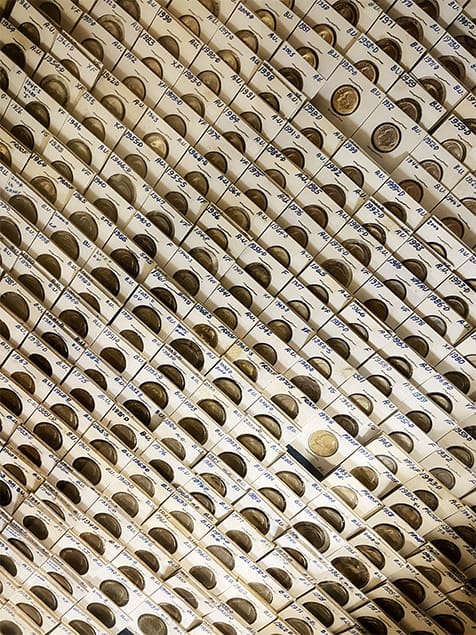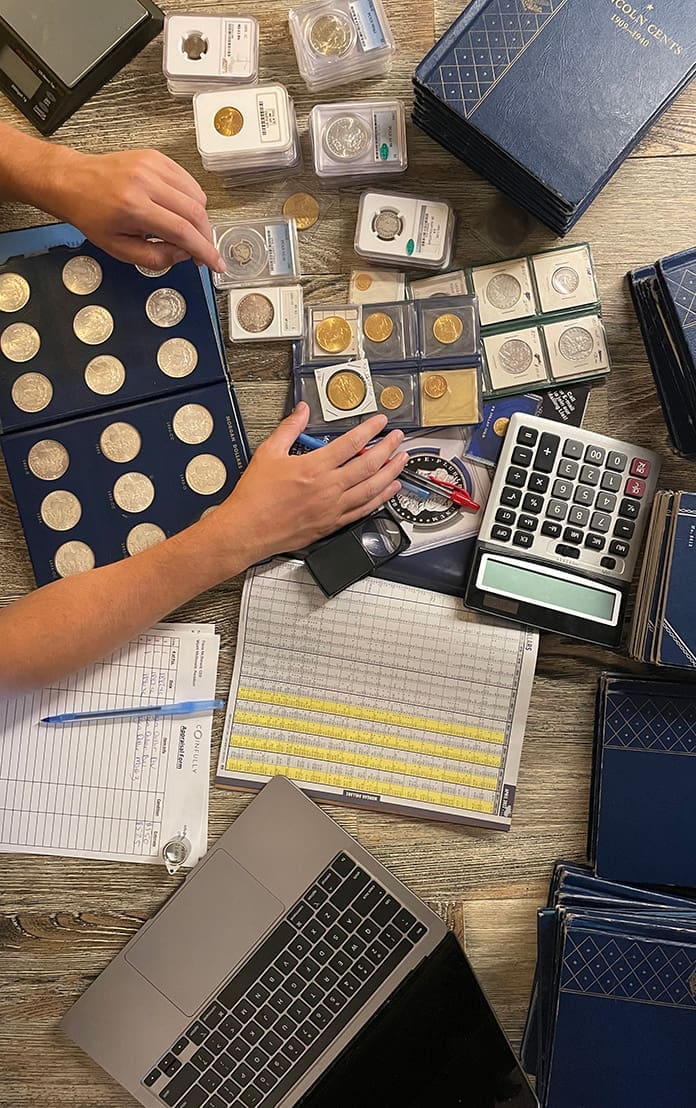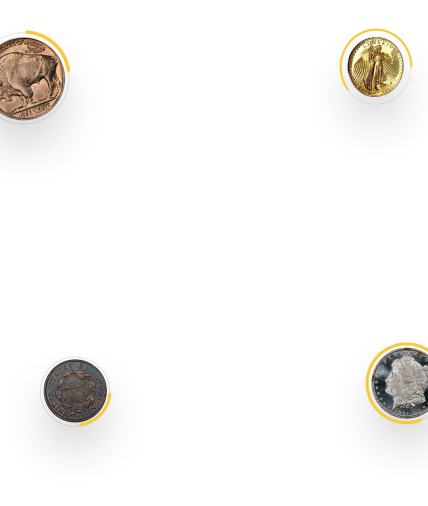Coins to look out for, WBTV interview numismatic items explained.
Is your loose change jar actually a goldmine? Which coins to look out for, whether you’ve inherited a coin collection or collected coins yourself.

Oct 10th, 2022 · 8 min read
In the wake of our president Wyatt McDonald’s TV appearance on WBTV’s QC@3, we wanted to expand on some of the topics he touched on in his interview.
At Coinfully, we will talk about coins and coin collecting with absolutely anyone for literally hours at a time, and it’s great to help people understand more about numismatics in interviews and articles to ensure you get the best possible value from your collection. But sometimes – especially in television/radio interviews – time is limited, and we don’t get the chance to fully explore some of the subjects we touch on.
Our priority is and always will be building up the knowledge base of our customers. The more you know about the coins in your possession, the more confidence you will have that the rare coin valuation you’ve been given for your collection is the right one. From there, any stress you’re feeling about selling your coins quickly disappears.

What happened to coins in 1964?
In his interview, Wyatt mentioned 1964 as being a watershed year for rare coin collectors. In the years just prior to that, the price of silver had shot up as demand for the metal for coins and for industry started to outstrip supply.
Silver was found in dimes, quarters and half dollars, and enthusiastic collectors began hoarding the coins, believing that the value of silver would keep rising and their coins would shoot up in value.
As people shoveled their coins into coffee tins instead of spending them, there was a widespread shortage, and banks started rationing how many coins they were putting into circulation.
That meant that in 1963 both banks and collectors were holding onto coins. Mints – which were working flat out to plow enough coins into circulation – could not make enough, and by 1964, the government decided it had to step in.
It removed silver from dimes and quarters and slashed the amount in the half dollar from 90 percent to 40 percent, eventually removing silver from the half dollar altogether. New silver-less coins began to be circulated in 1965, which alleviated the shortages and solved the problem.
So – any dime, quarter or half dollar you find that is made before 1964 is automatically worth up to 20 times what it says on the back. If you find one, we’d be very happy to appraise your coin for you.
The Wheat Penny
At the dawn of the 20th Century, the Treasury was busy redesigning US coins. For the cent, they went with a design featuring Abraham Lincoln (to mark 100 years since his birth) on the front and two ears of durum wheat on the back.
Almost as soon as it was issued on August 2 1909, it was withdrawn as the initials of the designer, Victor David Brenner, placed between the ears of wheat, were deemed to be too big. Just 484,000 of these coins were put into circulation, and they immediately became highly collectable. The coin was later reissued with Brenner’s initials installed below Lincoln’s shoulder, where they remain today.
Examples in average condition are now worth anything up to $1,000, with the very best condition coins fetching double that.
In 1959, the 150th anniversary of Lincoln’s birth, the wheat design was replaced by an image of the Lincoln Memorial in Washington, D.C.
The Washington quarter
Wyatt talked about the 1932 Washington quarter, which was made in Denver and San Francisco, as being particularly collectable.
This rare coin came out to mark the 200th birthday of our first president and features his bust portrait under the word LIBERTY on the obverse. The reverse depicts a perched eagle with spread wings above an olive branch. The mint mark – denoting where the coin was made – is underneath the eagle.
The 1932 coin is 90 percent silver, and, despite Treasury efforts to dampen down speculation that the coin would be commemorative, coin collectors immediately pounced on it and began hoarding examples.
The Denver mint struck 436,800 quarters, and the San Francisco mint struck 408,000. A really good circulated example of the San Francisco Washington quarter can fetch up to $300. An uncirculated one could earn you as much as $5,000.
Uncirculated Denver examples have sold at auction for more than $80,000!
With these high values in the air, many of the far more common Washington quarters struck in Philadelphia have had a false mint mark applied, so it’s essential to get your coin appraised by an trust coin dealer such as Coinfully.
The Flowing Hair dollar
The final coin Wyatt talked about was the Flowing Hair dollar, the very first dollar coin issued by the federal government, and, unlike the ones mentioned above, extremely unlikely to be at the bottom of your jar of coins.
Designed by Robert Scot, the Chief Engraver of the United States Mint at the time, The Flowing Hair dollar was initially produced in 1794. It depicts a portrait of Lady Liberty along with 15 stars (to mark that 15 states that had adopted the US Constitution up to that point) on one side and an eagle on the other.
The 1794 dollar has always been extremely highly prized among numismatists and is considered one of the rarest coins in existence. In the early 1990s, it was estimated that only 120 of the coins were still around.
The Flowing Hair dollar made the headlines in 2013 when the finest known example sold at auction for $10,016,875 – at the time, the highest selling price of any coin in history. Fun fact, Coinfully’s CEO, Travis McDonald, was the director of that very auction company (Stack’s Bowers Galleries) when this world record sale took place.
It was subsequently overtaken by an example of the 1933 Saint-Gaudens Double Eagle, which went for an eye-watering $18,872,250 at auction in 2021.
The $20 gold coin survived a mandate from President Roosevelt that all gold coins should be recalled from circulation and melted down. It is technically, therefore, illegal to own – but an exception was made for the one originally owned by King Farouk of Egypt, and its last owner was allowed to sell it.
How do I sell my coin collection for the right price?
We get asked this a lot – and this is where we can help. If you’ve got coins you think might be valuable or just want more information about, Coinfully offers a simple online appraisal. We service the whole country, and, because we operate with very low overhead, we can offer a market leading price – all you have to do is send us a couple of pictures and once your collection is validated payment is issued immediately.
At Coinfully we offer a reliable, realistic and transparent valuation. We’re coin collectors ourselves, with many years of experience in this field and know how to get you the best outcome for your whole family, whether you’ve inherited a coin collection or have gathered your own coin collection. We can even offer an in-person valuation service, completely free of charge, for people who need a valuation for a large coin collection.
Email our team today for a no-obligation chat. If you want to check right now what your coin or coin collection may be worth – check out our Instant Valuation guide here.

Coinfully Writing Team We are passionate about you receiving the best valuation for your collection. Our priority is always to educate collectors on their coins so they can have complete confidence in the decisions they make. Our process is ultra-transparent and undertaken without any pressure – so you can find out what your coins are worth without the stress.
Get an Appraisal
Think you’re onto something big with your collection? Let’s talk…





 401 Hawthorne Ln, Ste 110-323 - Charlotte, NC 28204
401 Hawthorne Ln, Ste 110-323 - Charlotte, NC 28204



